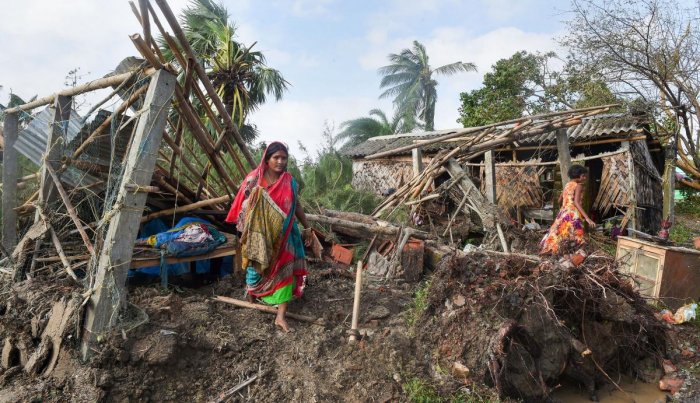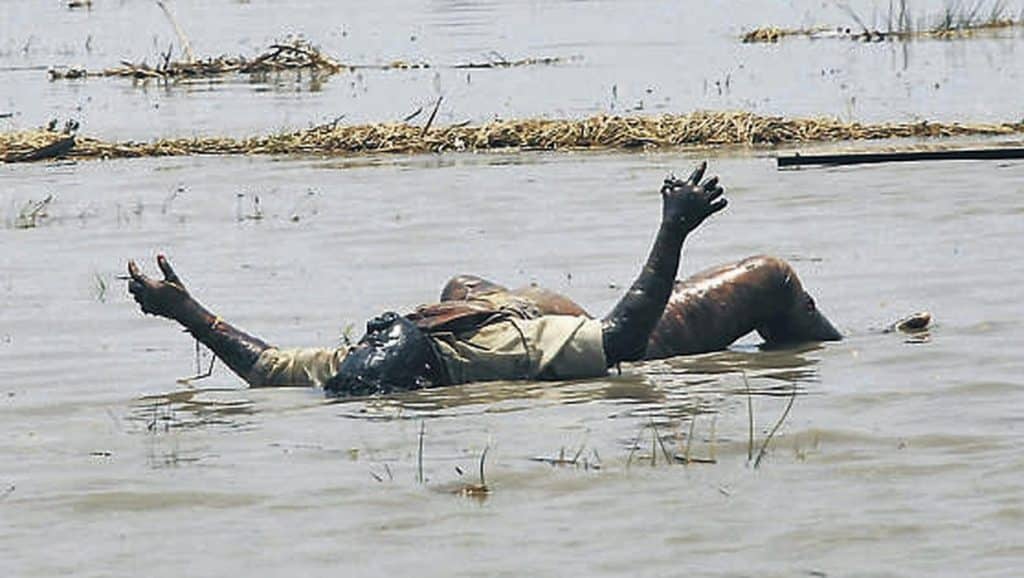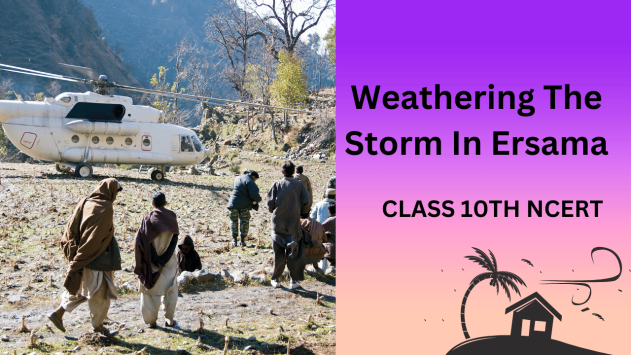We have shared Weathering The Storm In Ersama Class 9th NCERT along with NCERT Solutions For Class 9th Weathering The Storm In Ersama to help the class 9th students with the lesson so that they could go through the summary and get to know the skimmed part of the lesson.
We have also shared Weathering The Storm In Ersama Class 9th MCQs to help the students with the chapter in-depth and would able to know the type of questions asked in this article.

Weathering The Storm In Ersama Class 9th: Summary
This is a story about a young boy named Prashant, who belonged to Kalikuda village in the coastal state of Odisha. He lost his only support his mother, at an early age and this made him strong and mature in infancy.
On 27th October 1999, when he had gone to visit his friend, a super cyclone hit that area and all of them got stuck in one place. There was massive destruction all around. for two days there were strong winds and rain. all of them remained on the rooftop of the house and managed to survive by drinking coconut water.
As soon as the rain stopped, Prashant left for his home as he worried for them and thought he had lost all of them. He took the help of a stick to swim through the flood. On the way home, he met two of his friends and his uncle, and all of them moved together. Amidst their movement, they came across carcasses of humans and animals.
When they crossed the village, they could even see a single house. Only they could see was destruction everywhere. Prashant’s house was also shattered and he saw his providence everywhere hanging on the nearby branches.
Soon, he went to the Red Cross community to seek help for shelter and food. Many had lost their loved ones all of them were in deep grief as they were left with nothing. For the last, they survived on tender coconuts. Prashant showed maturity at this very stage and took over the bad situation. he organized some members into a group and forced the merchant to give them the rice and grains to eat.
After 4 days they could eat a proper meal, then they also volunteered to help the injured people during the storm. Prashant got involved in a group called, ” Food For Work” to help the widows work and arranged the children by arranging sports for all of them. Prashant along with the volunteers managed to set up foster families for the widows, orphaned, and lone men. By doing all this, Prashant came over his grief and smile back from the gloomy days.
Weathering The Storm In Ersama Class 9th: MCQs
| Q1- What does this lesson speak about?
A) storm
|
| Q2- Where did the storm hit?
A) Coastal town of Ersama in Odisha
|
| Q3- When did the storm hit the town Ersama?
A) 1989
|
| Q4- Who faced the fury of the storm?
A) A young boy Prashant |
| Q5- How old was Prashant?
A) 18 years
|
| Q6- What was the name of Prashant’s village?
A) Maligudi
|
| Q7- Why did Prashant go to Ersama?
A) to see a new place
|
| Q8- How did people in Ersama survive during the storm?
A) by eating tender coconut and remaining on the rooftops
|
| Q9- Who did Prashant meet on the way back home after the storm?
A) two friends and their uncle |
| Q10- What was the impact of the cyclone?
A) destruction
|
| Q11- How did Prashant help the storm victims?
A) by arranging food for them
|
| Q12- Whom did the flood victims send signals for food help?
A) Military helicopters
|
| Q13- Who helped the orphans?
A) widow women
|
| Q14- Why did Prashant and other volunteers not want a separate institution for widows and orphans?
A) to save them from isolation and grief-stricken feelings
|
| Q15- What are the things which could be used by youngsters to help overcome any adversity?
A) strength |
Answer key
| Q. No. | Answer | Q. No. | Answer |
| 1 | C | 11 | D |
| 2 | A | 12 | A |
| 3 | D | 13 | A |
| 4 | A | 14 | A |
| 5 | C | 15 | D |
| 6 | B | 16 | A |
| 7 | C | 17 | A |
| 8 | A | 18 | D |
| 9 | A | 19 | C |
| 10 | D | 20 | A |
Character Sketch of Prashant
Prashant was a young boy who played a major role in resurrecting his family and
his villagers after they were devastated by a cyclone in the year 1999.
Sitting on the rooftop of his friend’s house, alive but not safe, the only thought that passed through his mind was the safety of his people. As soon as the storm receded, he willfully went back to his village, with a lot of fear and worry.
When he got back and saw the state of affairs, he gathered himself up with strength and passion, garnered the support of a team of youngsters, and worked relentlessly towards the upliftment of the destroyed village. It is very reassuring to see how this young man puts on the mantle of leadership and selflessly serves the entire community.
His commitment and dedication serve as an eye-opener to the keepers of the nation. He did not just work up a team and issue instructions but was on the ground to ensure the mental and physical upliftment of his near and dear ones.
Weathering The Storm In Ersama Class 9th: RTC
Read the following passages and answer the questions:
1. “ On 27 October 1999, seven years after his mother’s death, Prashant had gone to the block
headquarters of Ersama, a small town in coastal Orissa, some eighteen kilometers from
his village, to spend the day with a friend. In the evening, a dark and menacing storm
quickly gathered. Winds beat against the houses with a speed and fury that Prashant had
never witnessed before.
a. When did Prashant go to the block headquarters of Ersama?
b. Why did Prashant go to Ersama?
c. How far was the town from his village?
d. What happened in the evening?
2. “For the next two days, Prashant sat huddled with his friend’s family in the open on the
rooftops. They froze in the cold and incessant rain; the rainwater washed away
Prashant’s tears. The only thought that flashed through his mind was whether his family
had survived the fury of the super cyclone. Was he to be bereaved once again?
1. What had Prashant done for the next two days?
2. What happened to Prashant and his friend’s family?
3. What washed away Prashant’s tears?
4. What was the only thought that flashed through Prashant’s mind?
Answers-
1. a. Prashant went to the headquarters seven years after his mother’s death on 27
October 1999.
b. Prashant went to Ersama to a friend’s house to spend a day with him.
c. The town was some eighteen kilometers away from his village.
d. In the evening a dark menacing storm gathered, and winds beat against the houses with speed and fury.
2. a. Prashant sat huddled with his friend’s family in the open on the rooftops for the next
two days.
b. They froze in the cold and incessant rain. They sat on the rooftops.
c. Incessant rain washed away Prashant’s tears.
d. The only thought that flashed through Prashant’s mind was whether his family had
survived the fury of the cyclone.
NCERT Solutions For Class 9th Weathering The Storm In Ersama
1. What havoc has the super cyclone wreaked in the life of the people of Orissa?
The cyclone brought with it heavy rains and strong winds. As a result, a majority of
houses were demolished or blown away and only the strong cement houses were
spared. Dirty water covered the land as far as the eye could see.

Many people lost their lives. Floating human bodies and bloated animal carcasses were seen all around. The strongest of the trees had been uprooted. The scenes were gruesome. Many people lost their relatives and many children had become orphans. There was a shortage of food. People were sad and helpless, and a pall of gloom had descended on the people all around.
2. How has Prashant, a teenager, been able to help the people of his village?
Prashant set out on his trip back to his village which was eighteen kilometers away
with the help of a sturdy stick. He tried to get a grip on himself because he was
shocked when he saw the effects of the cyclone.
He decided to step in as the leader of his village. He organized a group of youths and elders to jointly pressurize the merchant to give rice to the people living in the shelter. He was successful in this task. He then organized a team of youth volunteers to clean the shelter and tend to the wounds of the people who had been injured in the cyclone.
Prashant also brought a number of orphaned children together and constructed a
polythene shelter for them. While women were mobilized to look after them, the men
secured food and other essentials for the shelter.
When he realized that the women were becoming too grief-stricken, he persuaded them to start working in the food-for-work program, which was initiated by an NGO. He also organized sports events for children. He worked selflessly to get his village and its people back on their feet.
3. How have the people of the community helped one another? What role do the women of Kalikuda play these days?
The people of the community got together and began to help one another under
the leadership of young Prashant. They pressurized the merchant to part with the rice,
he had hoarded for the people in the shelter.
They gathered branches from fallen trees to use as firewood for cooking. The military helicopter dropped some food parcels but did not return them.
The youth task force gathered empty utensils from the shelter and made the children lie in the sand with the utensils on their stomachs to communicate to the passing helicopters that they were hungry. The message went through and the helicopters became more consistent in air-dropping food and other basic needs.
Women were mobilized to look after the orphans, while the men secured food and
materials for the shelter. In spite of being grief-stricken, the women started working in the
food-for-work program started by an NGO. Everyone contributed according to their
capabilities. The village stood together in their moment of crisis.
4. Why do Prashant and other volunteers resist the plan to set up institutions for orphans and widows? What alternatives do they consider?
Prashant and his group of young volunteers resisted the plan of setting up
institutions for orphans and widows because they feared that they would be required
to lead a life without love, affection, and loneliness. Besides, they worried about the
stigma that the widows would have to deal with.
They alternately planned to resettle them in their own community to provide them with a homely environment. They suggested setting up foster families that would comprise childless widows who would take care of the orphaned children.
5. Do you think Prashant is a good leader? Do you think young people can get together to help people during natural calamities?
Yes, Prashant is a good leader. He forgot his personal grief when he saw the
the plight of his village and villagers got hold of himself and decided to lead the excavation, evacuation, and relief activities.
He was able to garner the support of all the villagers, and as a team, they stood together in their moment of crisis. This is a great example to emulate. It is the young who should get together to help people in distress, however, simple or severe they may be. They have the physical and mental strength and presence of mind to act in the right manner, simultaneously setting examples for their young ones.
Short Answer Questions (30-40 words: 2 Marks each)
1. What happened in the evening when Prashant was at his friend’s house in
Ersama?
It was the 27th of October, young Prashant had gone to his friend’s house which
was about 18 kilometers from his village. Suddenly, in the evening, a dark storm
gathered, and strong winds started blowing with great speed and uprooted trees. The heavy and incessant rains caused the water levels to rise. The angry water rushed inside.
They were neck-deep in water. Houses, livestock, and human beings got razed to the
ground and were floating lifelessly.
2. How did Prashant spend the first two days after the cyclone?
Prashant was at his friend’s house when the cyclone struck. All of them climbed
onto the roof of the house to escape the impact of the gushing waters. He was up there
for two days. They had nothing to eat but survived on the tender coconuts that had
fallen off from the coconut trees that had crashed onto their roof.
3. Who was long given up as dead?
Prashant’s maternal grandmother was the first person he spotted when he came
back to his village. Weak and hungry, she rushed up to him with her hands outstretched
and eyes overflowing with relief because the entire family had assumed that he would
have been swallowed by the cyclone. Many hours had gone by, and no one had seen
him, but with the grace of God, he returned to secure his people.
4. “Was he to be bereaved once again? Explain.
Prashant was stuck for nearly two days on the roof of his friend’s house. And 48
hours seemed a very long time. He was in tears and was disturbed and concerned
about his family and their safety. This doubt occurs him, whether he would be
bereaved again, because he had already lost his mother seven years back, and losing
someone again was very painful for the young man. He was, therefore, worried that he
would be bereaved again because of the devastating cyclone.
5. How did Prashant contribute to improving the condition of the shelter?
The condition of the shelter was very pathetic. There was a fear of spreading
the epidemic. Moreover, people were depressed, hungry, and wounded. Prashant tackled all these problems wisely.
First of all, he took up the responsibility of a leader. He organized a group of youths and elders who were able to compel the merchant to provide from his hoarded stock of rice. They collected wood, cooked rice, and fed the people.
Then he arranged a team of youths to clean all the surroundings of the shelter.
They looked after the wounded. He persuaded women to look after the orphans. He
worked towards giving them mental happiness by organizing games and matches for
the young.
To make the widowed women self-sufficient and strong, he convinced women to work for food. His sincerity toward the problem at hand and his exceptional handling of the crisis is a great example of courage and compassion.
6. How have the people of the community helped one another? What role do the women of Kalikuda play these days?
The people of the community got together and began to help one another under
the leadership of young Prashant. Together they pressurized the merchant to part with his rice for the people in the shelter. They gathered branches from fallen trees and lit a fire, on which they cooked rice for all to eat.
When the military helicopter dropped some food parcels but did not return, the youth task force gathered empty utensils from the shelter and made the children lie in the sand with the utensils on their stomachs to communicate to the passing helicopters that they were hungry.
The message went through and the helicopter made regular rounds of the shelter, airdropping food and other basic needs. Women were mobilized to look after the orphans, while the men secured food and materials for the shelter. In spite of being grief-stricken, the women started working in the food-for-work program started by an NGO.
7. What do Prashant and other volunteers resist the plan to set up institutions for orphans and widows? What alternatives do they consider?
The plan to set up institutions for orphans and widows was resisted because it was
believed that in such institutions children will grow up without love and affection and
widows would suffer from stigma and loneliness. Instead, Prashant and his group suggested that the children and widows should be resettled in their own community where they can get a homely environment. They suggested setting up foster families made up of childless widows and children without adult care.
8. Do you think Prashant is a good leader? Do you think young people can get together to help people during natural calamities?
Yes, Prashant is a very good leader. Though he himself was too grief-stricken, he
got a hold of himself and decided to step in as the leader of the village. He carried out his
role effectively and helped the people of his village in every possible manner. Yes. Young people can definitely get together to help people during natural calamities and
otherwise. They can use their strength and vigor to help people.
9. How has Prashant, a teenager, been able to help the people of his village?
Prashant helped the people of his village by first getting a grip over himself because
he was initially shocked at witnessing the aftereffects of the cyclone. He decided to step in
as the leader of his village.
He organized a group of youths and elders to jointly pressurize the merchant to give rice to the people living in the shelter. He was successful in this task. His next task was to organize a team of youth volunteers to clean the shelter and tend to the wounds of the people who had been injured because of the cyclone.
Prashant also brought a number of orphaned children together and constructed a polythene shelter for them. While women were mobilized to look after them, the men secured food and other essentials for the shelter. When he realized that the women were becoming too grief-stricken, he persuaded them to start working in the food-for-work program, which was initiated by an NGO. He also organized sports events for children.
10. What havoc has the super cyclone wreaked in the life of the people of Orissa?
The cyclone brought heavy rains and strong winds. As a result, the majority of the
houses had blown away and only the strong cement houses were spared. Dirty water
covered the land as far as the eye could see.
Many people lost their lives. There were floating human bodies and bloated animal carcasses all around. Even the strongest of the trees had been uprooted. The scenes were gruesome. Many people lost their relatives and many children had become orphans. There was a shortage of food. People were sad and helpless and a pall of gloom had descended on the people all around.
Conclusion
We have shared Weathering The Storm In Ersama Class 9th NCERT along with NCERT Solutions For Class 9th Weathering The Storm In Ersama to help the class 9th students with the lesson so that they could go through the summary and get to know the skimmed part of the lesson. We have also shared Weathering The Storm In Ersama Class 9th MCQs to help the students with the chapter in-depth and would able to know the type of questions asked in this article.
Related Articles

